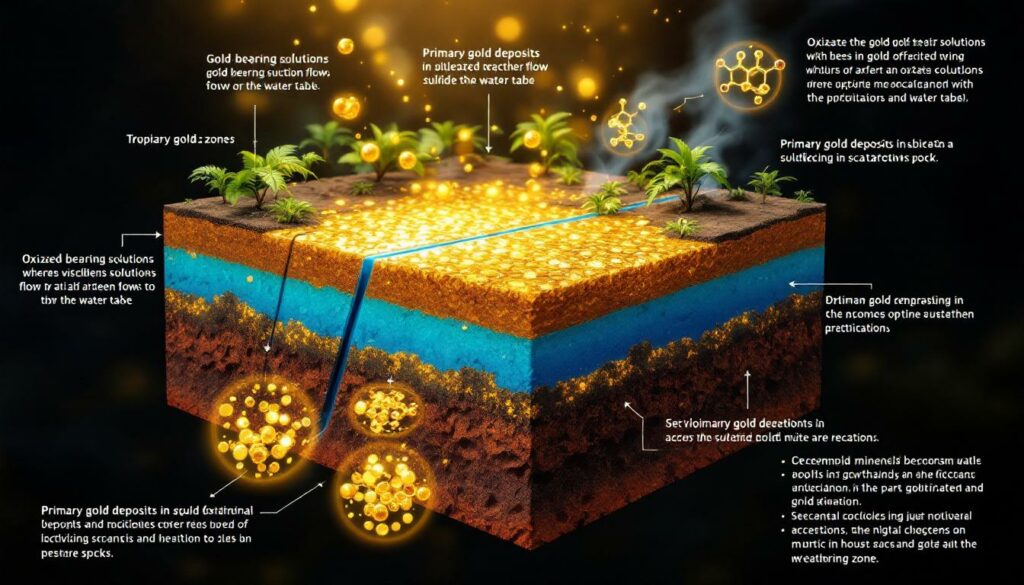What Are Gold Enrichment Zones?
Gold enrichment zones represent nature's own gold concentration factory – geological layers where secondary processes have significantly increased gold content beyond the original deposit levels. Unlike primary mineralization that occurs deep within the Earth, these zones develop through weathering and chemical reactions near the surface, transforming previously uneconomical deposits into viable mining targets.
These specialized zones typically form within or just below the oxidation zone of a deposit—the upper portion exposed to atmospheric conditions over time. They create a distinct layer, often positioned at the boundary where oxidizing conditions transition to reducing environments, usually near the water table.
Definition and Formation Process
Gold enrichment zones are geological phenomena where natural processes have concentrated gold to levels significantly higher than surrounding rock. These secondary concentration mechanisms can increase gold grades by factors of 2-10 times compared to the primary mineralization, creating high-value targets for mining operations.
The process involves complex interactions between rock, water, oxygen, and various chemical compounds that dissolve, transport, and reprecipitate gold in concentrated forms. This natural enrichment process has created some of the world's most economically significant gold deposits analysis.
Location Within Deposits
Within a typical gold deposit, enrichment zones occupy predictable positions based on geochemical boundaries:
- Upper zone: Completely leached material with little remaining gold
- Middle zone: The enrichment horizon where gold has concentrated
- Lower zone: Primary mineralization with original, unaltered gold values
The most significant enrichment typically occurs at or just below the water table, where changing chemical conditions force dissolved gold to precipitate. These zones can vary from just a few meters to tens of meters thick depending on local conditions.
Typical Characteristics
Gold enrichment zones display several distinctive features that help geologists identify them:
- Visibly oxidized rock with iron-staining (yellow, red, or brown coloration)
- Secondary minerals like goethite, hematite, and jarosite
- Higher porosity than surrounding rock due to dissolution of minerals
- Visible gold particles that are often larger and more abundant than in primary ore
- Absence or alteration of original sulfide minerals
In tropical regions with intense weathering, these zones can extend hundreds of meters deep, while in arid environments, they may be much shallower but still highly concentrated.
How Do Gold Enrichment Zones Form?
The formation of gold enrichment zones involves a fascinating sequence of geochemical reactions that unfold over thousands to millions of years. This natural process transforms ordinary gold deposits into concentrated zones of exceptional value through weathering, dissolution, and reprecipitation.
The Weathering and Oxidation Process
The journey begins when primary gold deposits, often locked within sulfide minerals, become exposed to surface conditions through geological uplift and erosion. As rainwater and atmospheric oxygen penetrate the rock mass, they initiate a cascade of chemical reactions:
- Oxygen attacks sulfide minerals (pyrite, arsenopyrite, chalcopyrite)
- Sulfides oxidize to form sulfuric acid and iron oxides
- The resulting acidic conditions accelerate further breakdown of minerals
- Original rock textures become altered as minerals dissolve or transform
This weathering process is particularly intense in tropical climates where abundant rainfall and warm temperatures accelerate chemical reactions. The acidic environment created by sulfide oxidation becomes crucial for the next stage in gold enrichment.
Gold Mobilization and Transport
Although gold is generally considered inert, specific chemical conditions can make it surprisingly mobile:
- In acidic, oxidizing environments, gold can form complexes with chloride, thiosulfate, or organic compounds
- These gold complexes become soluble in groundwater
- Bacteria may play a catalytic role in some gold dissolution processes
- The dissolved gold migrates downward through fractures, pores, and permeable layers
- The concentration of dissolved gold in these solutions is typically very low (parts per billion)
Research by the CSIRO (Commonwealth Scientific and Industrial Research Organisation) has demonstrated that certain bacteria can facilitate gold dissolution and transport in natural systems, challenging earlier beliefs about gold's immobility in surface environments.
Precipitation and Concentration
The final and most economically significant stage occurs when gold-bearing solutions encounter conditions that force gold out of solution:
- As solutions reach the water table, oxygen levels decrease
- Reducing conditions cause gold complexes to become unstable
- Gold precipitates along with iron oxides and other secondary minerals
- The process continues as long as gold-bearing solutions feed the zone
- Over time, gold accumulates in a concentrated layer
This precipitation zone becomes the enrichment horizon, where gold grades can be many times higher than in the primary ore. The combination of gold leached from a large volume of rock concentrating in a much smaller zone creates the economic potential that miners prize.
Key Factors Influencing Gold Enrichment Zone Formation
Not all gold deposits develop significant enrichment zones. The formation process depends on a complex interplay of geological, climatic, and chemical factors that must align to create economically meaningful concentrations.
Climate Conditions
Climate plays a decisive role in enrichment zone development:
- Tropical environments: Accelerated weathering due to high rainfall and temperatures
- Seasonal wet-dry cycles: Enhanced oxidation as water levels fluctuate
- Arid regions: Slower development but preservation of enrichment zones once formed
- Rainfall chemistry: Slightly acidic rain can accelerate weathering processes
The world's most extensive gold enrichment zones tend to occur in tropical to subtropical regions. For example, West Africa's gold belts feature some of the most well-developed enrichment profiles due to their long-term exposure to tropical weathering conditions.
Host Rock Properties
The composition and structure of the host rock significantly impact enrichment potential:
- Permeability: Allows water circulation through the rock mass
- Fracture density: Creates pathways for solution movement
- Sulfide content: Provides source material for acid generation
- Buffering capacity: Carbonate-rich rocks neutralize acid and limit gold mobility
- Original gold distribution: Determines the amount available for redistribution
Ideal host rocks contain abundant sulfides, minimal carbonates, and extensive fracture networks. Volcanic and metamorphic rocks often provide favorable conditions for enrichment zone development.
Geochemical Environment
The chemical conditions within the deposit determine how effectively gold is concentrated:
- pH levels: Acidic conditions promote gold mobility
- Redox potential: Controls whether gold dissolves or precipitates
- Presence of complexing agents: Chloride, thiosulfate, and humic substances facilitate gold transport
- Electrochemical cells: Can develop between different mineral phases
- Bacterial activity: Microorganisms can catalyze both dissolution and precipitation
Recent research has shown that naturally occurring bacteria can significantly accelerate gold mobility by producing compounds that complex with gold or by creating microenvironments with specialized chemical conditions.
Time Factors
Enrichment zones develop over extended geological periods:
- Typical timeframes: Thousands to millions of years for significant enrichment
- Tectonic stability: Required for preservation of weathering profiles
- Erosion rates: Must be balanced with weathering rates
- Water table stability: Prolonged stable conditions enhance concentration
The world's most spectacular enrichment zones have often developed in regions with remarkable geological stability, allowing weathering processes to operate uninterrupted for millions of years.
Why Are Gold Enrichment Zones Economically Important?
Gold enrichment zones represent some of the most economically attractive targets in the mining industry, offering multiple advantages that can dramatically improve project economics and development strategies.
Enhanced Ore Grade and Value
The most significant economic impact comes from the substantial increase in gold concentration:
- Grade multiplication: Primary ore grades of 0.5-2 g/t can be enriched to 2-20 g/t
- Value density: Higher grades mean more gold per ton of processed material
- Resource expansion: Previously sub-economic resources become viable
- Reserve quality: Higher-confidence resource classification due to visible gold
This natural concentration effect essentially provides free "ore upgrading" that would otherwise require costly processing technologies. For junior mining companies, finding significant enrichment zones can be the difference between a marginal and a highly profitable project.
Mining and Processing Advantages
Enrichment zones offer several operational benefits:
- Shallow location: Reduced stripping ratios and lower mining costs
- Soft material: Easier drilling, blasting, and crushing requirements
- Free-milling gold: Higher recovery rates with standard processing
- Reduced reagent consumption: Less cyanide required for extraction
- Lower energy costs: Less grinding required for liberation
- Simplified metallurgy: Absence of problematic sulfides and carbon
These operational advantages translate to lower production costs per ounce of gold recovered. Processing oxide ore from enrichment zones typically costs 30-50% less than processing primary sulfide ore from the same deposit.
Exploration Significance
For exploration geologists, enrichment zones provide valuable indicators:
- Surface expressions: Visible features guide initial exploration efforts
- Pathfinders: Secondary minerals indicate potential enrichment
- Deposit indicators: May signal larger primary mineralization at depth
- Low-cost targeting: Surface sampling can identify promising areas
- Quick validation: Early drilling results interpretation can provide proof of concept
The presence of enrichment zones has led to the discovery of many major gold deposits worldwide, as explorers followed the enrichment signature to uncover the primary mineralization below.
Project Economics and Development Strategy
Enrichment zones can fundamentally alter a project's economic profile:
- Early cashflow: High-grade, low-cost production in initial years
- Capital efficiency: Lower upfront investment requirements
- Phased development: Start with oxide ore before tackling sulfides
- Risk reduction: Faster payback period reduces financial exposure
- Financing advantage: More attractive to investors and lenders
Many successful gold mining operations have used enrichment zones as "starter pits" to generate early returns that fund the development of larger, more complex operations targeting the primary mineralization.
How Are Gold Enrichment Zones Identified?
Discovering and delineating gold enrichment zones requires a systematic approach combining field observations, sampling techniques, geophysical methods, and laboratory analysis.
Surface Indicators and Sampling
Field geologists look for specific surface features:
- Gossans: Distinctive iron-rich oxidized caps with characteristic colors
- Boxworks: Cellular textures where sulfides have been leached out
- Secondary minerals: Presence of jarosite, goethite, hematite, and limonite
- Quartz textures: Vuggy or honeycomb appearance in quartz veins
- Color anomalies: Yellow, red, or brown staining in outcrops
Surface sampling programs target these features, with techniques including:
- Soil sampling on systematic grids
- Rock chip sampling of outcrops
- Trenching across projected enrichment zones
- Stream sediment sampling in drainage areas
- Biogeochemical sampling using plants
These initial sampling programs help identify areas with enrichment potential before committing to more expensive drilling campaigns.
Drilling and Subsurface Investigation
Confirming enrichment zones requires systematic drilling:
- RAB/Aircore drilling: Initial shallow testing of oxidized zones
- RC drilling: Cost-effective method for defining enrichment extent
- Diamond drilling: Provides detailed information on structures and textures
- Oriented core: Helps understand structural controls on enrichment
- Downhole geophysics methods: Provides information between drill holes
Drilling patterns typically involve fence lines of holes across the suspected enrichment zone, with closer spacing as the project advances. Logging procedures carefully document oxidation boundaries, mineral assemblages, and visible gold occurrences.
Geophysical Methods
Various geophysical techniques help map enrichment zones:
- Induced Polarization (IP): Detects contrast between oxidized and sulfide zones
- Resistivity surveys: Identify changes in groundwater chemistry and rock porosity
- Magnetic surveys: Map distribution of magnetic minerals altered by oxidation
- Electromagnetic methods: Detect conductivity differences in weathered profiles
- Ground Penetrating Radar: Image shallow oxidation boundaries
Modern drone-based magnetometry has revolutionized the mapping of oxidized zones, providing high-resolution data at a fraction of the cost of traditional ground surveys.
Geochemical Analysis
Laboratory testing provides critical data:
- Multi-element analysis: Identifies pathfinder elements (As, Sb, Bi, Te)
- Sequential leaching: Determines different gold associations
- Mineralogical studies: Characterizes host minerals using XRD, SEM, or optical methods
- Gold deportment studies: Determines gold particle size and associations
- Metallurgical testing: Assesses recovery characteristics
Advanced techniques like laser ablation ICP-MS can now detect gold at extremely low concentrations, helping identify subtle enrichment patterns that might be missed by conventional assay methods.
Challenges in Evaluating Gold Enrichment Zones
Despite their economic appeal, gold enrichment zones present unique challenges for resource evaluation, mining, and processing that require specialized approaches to address effectively.
Geological Variability
Enrichment zones present several geological challenges:
- Lateral discontinuity: Enrichment can be patchy and irregular
- Variable thickness: From meters to tens of meters within short distances
- Complex boundaries: Gradational transitions between oxidation states
- Multiple horizons: Stacked enrichment layers with different characteristics
- Structural complexity: Faulting and folding affecting enrichment patterns
This variability makes it difficult to predict enrichment zone characteristics between drill holes, requiring closer-spaced drilling than might be needed for primary mineralization.
Resource Estimation Difficulties
Accurately quantifying resources in enrichment zones requires:
- Statistical challenges: Highly skewed grade distributions with extreme values
- Domaining complexity: Separating different oxidation and enrichment zones
- Nugget effect: Coarse gold particles creating sampling variability
- Support effect: Sample size influences grade estimation
- Estimation method selection: Appropriate techniques for highly variable grades
Resource geologists often employ multiple estimation methods (kriging, inverse distance, nearest neighbor) to compare results and understand estimation uncertainty in these complex zones.
Mining and Processing Considerations
Operational challenges include:
- Grade control: Frequent sampling and assaying during mining
- Dilution management: Preventing mixing of different ore types
- Transition planning: Managing the shift from oxide to sulfide ore
- Metallurgical variability: Changing recovery rates across the enrichment profile
- Water management: Dealing with potentially acid-generating materials
The transition zone between fully oxidized and primary sulfide ore often presents the most difficult processing challenges, with mixed mineralogy requiring specialized treatment methods.
Environmental Factors
Environmental considerations specific to enrichment zones include:
- Naturally acidic materials: Partially oxidized sulfides can generate acid
- Metal mobility: Arsenic, antimony, and other metals may be more soluble
- Dust management: Fine-grained oxidized material requires careful handling
- Groundwater impacts: Potential for metal leaching into aquifers
- Closure planning: Long-term stability of exposed enrichment profiles
Responsible development requires comprehensive characterization of these environmental risks before mining begins, with appropriate management strategies incorporated into the mine plan.
Notable Examples of Gold Enrichment Zones Worldwide
Gold enrichment zones have created some of the world's most remarkable gold deposits, with distinctive characteristics reflecting their unique geological settings and development histories.
Australian Examples
Australia hosts several significant enrichment zones:
-
Boddington (Western Australia): One of the world's largest gold mines features extensive supergene enrichment over a porphyry system. The oxide zone contained approximately 2 million ounces of gold at grades 50-100% higher than the primary mineralization.
-
Telfer (Western Australia): Located in the Great Sandy Desert, Telfer's enrichment zone developed in an arid environment, creating a complex oxidation profile extending to 150 meters depth with significantly higher grades than the primary ore.
-
Tanami region deposits: In Australia's Northern Territory, deposits like Callie and Dead Bullock Soak feature significant enrichment despite the arid conditions, demonstrating how even limited rainfall can create meaningful enrichment over geological timeframes.
North American Deposits
The Americas feature world-class examples:
-
Carlin Trend (Nevada): The oxidized zones above the carbonaceous gold deposits of the Carlin Trend provided the initial high-grade, easily processed ore that launched Nevada's gold industry. These oxide caps typically contained grades 30-50% higher than the underlying sulfide ore.
-
Yanacocha (Peru): One of the largest gold mines in South America, Yanacocha features extensive high-grade enrichment in a volcanic setting. The deposit contained over 35 million ounces of gold, much of it in near-surface oxide enrichment zones that enabled low-cost heap leach processing.
-
La Coipa (Chile): This high-altitude deposit demonstrates how enrichment can occur even in extreme environments. The enrichment zone developed in epithermal volcanic rocks, creating a high-grade oxide cap above the primary sulfide mineralization.
African Examples
Africa's tropical climate has produced remarkable enrichment zones:
- Sadiola (Mali): This West African deposit features a classic weathering profile extending over 100 meters deep, with significant gold enrichment in the saprolite (completely weathered rock) and saprock (partially weathere
Ready to Catch the Next Major Gold Discovery?
Stay ahead of the market with real-time alerts on significant ASX mineral discoveries through Discovery Alert's proprietary Discovery IQ model, which transforms complex geological data into actionable investment opportunities. Explore why major mineral discoveries can lead to exceptional returns by visiting Discovery Alert's dedicated discoveries page and start your 30-day free trial today.




